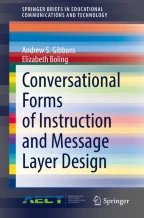Instruction as a Conversation: The Imperative for Message Layer Design

The architectural theory of instructional design (Gibbons, 2014; Gibbons & Rogers, 2009) identifies seven major functions carried out by instruction, coinciding with seven independently designable “layers” of a design. The message layer is one of these. The purpose of this monograph is to establish the validity and utility of the message layer as an important functional unit of an instructional design. Doing so would represent a major step forward in our understanding of instructional design theory and practice.
This is a preview of subscription content, log in via an institution to check access.
Access this chapter
Subscribe and save
Springer+ Basic
€32.70 /Month
- Get 10 units per month
- Download Article/Chapter or eBook
- 1 Unit = 1 Article or 1 Chapter
- Cancel anytime
Buy Now
Price includes VAT (France)
eBook EUR 50.28 Price includes VAT (France)
Softcover Book EUR 63.29 Price includes VAT (France)
Tax calculation will be finalised at checkout
Purchases are for personal use only
Notes
For example, computer and software design, tool and equipment design, architectural design and structural engineering, business and organizational design, automotive and aircraft design, and others. See, for example, Goldstein & Bobrow, 1980; Brand, 1994; Fowler & Beck, 1999; Baldwin & Clark, 2000; Simmonds & Ing, 2000.
References
- Baldwin, C., & Clark, K. (2000). Design rules: The power of modularity. MIT Press. BookGoogle Scholar
- Brand, S. (1994). How buildings learn: What happens after they’re built. Penguin. Google Scholar
- Brooks, F. P. (2010). The design of design: Essays from a computer scientist. Addison-Wesley Professional. Google Scholar
- Bucciarelli, L. L. (1994). Designing engineers. MIT Press. Google Scholar
- Fowler, M., & Beck, K. (1999). Refactoring: Improving the design of existing code. Addison-Wesley Professional. Google Scholar
- Fox, B. A. (1993). The human tutorial dialogue project: Issues in the design of instructional systems. Lawrence Erlbaum Associates. Google Scholar
- Gibbons, A. S. (2001). Model-centered instruction. Journal of Structural Learning and Intelligent Systems, 14(4), 511–540. Google Scholar
- Gibbons, A. S. (2003). What and how do designers design? A theory of design structure. TechTrends, 47(5), 22–27. Google Scholar
- Gibbons, A. S. (2014). An architectural approach to instructional design. Routledge. Google Scholar
- Gibbons, A. S. (2020). What is instructional strategy? Seeking hidden dimensions. Educational technology, research and development. Published online: 3 September 2020. Available at: https://rdcu.be/b6Ldw; https://doi.org/10.1007/s11423-020-09820-2.
- Gibbons, A. S., & Bunderson, C. V. (2004). Explore, explain, design. In K. Kempf-Leonard (Ed.), Encyclopedia of social measurement (pp. 927–938). Elsevier Science. Google Scholar
- Gibbons, A. S., & Langton, M. B. (2016). The application of layer theory to design: The control layer. Journal of Computing in Higher Education, 28, 97–135. http://scholarsarchive.byu.edu/facpub/2968ArticleGoogle Scholar
- Gibbons, A. S., Nelson, J. S. & Richards, R. E. (1999a). Theoretical and practical requirements for a system of pre-design analysis. White paper prepared for the Human-Systems Simulation Center of the Idaho National Engineering and Environmental Laboratory, Idaho Falls, ID. https://scholarsarchive.byu.edu/facpub/1330
- Gibbons, A. S., Nelson, J. S. & Richards, R. E. (1999b). Model-centered analysis process (MCAP): A pre-design analysis methodology. White paper prepared for the Idaho National Engineering and Environmental Laboratory, Idaho Falls, ID. https://scholarsarchive.byu.edu/facpub/1328.
- Gibbons, A. S., Nelson, J. S., & Richards, R. E. (2000). The nature and origin of instructional objects. In D. Wiley (Ed.), The instructional use of learning objects (pp. 25–58). Association for Educational Communications and Technology. Google Scholar
- Gibbons, A. S., & Rogers, P. C. (2009). The architecture of instructional theory. In C. M. Reigeluth & A. Carr-Chellman (Eds.), Instructional-design theories and models, volume III. Lawrence Erlbaum Associates. Google Scholar
- Goldstein, I. P., & Bobrow, D. G. (1980). A layered approach to software design. Report no. CSL-80-5. Xerox Corporation. Google Scholar
- Gross, M., Ervin, S., Anderson, J., & Fleisher, A. (1987). Designing with constraints. In Y. Kalay (Ed.), Computability of design (pp. 53–83). Wiley. Google Scholar
- Helps, R. (2007). Dancing on quicksand gracefully: Instructional design for rapidly evolving technology courses. SIGITE ‘07: Proceedings of the 8th ACM SIGITE conference on information technology education, 1–8. https://doi.org/10.1145/1324302.1324304.
- Heritage, J. (2013). Epistemics in conversation. In J. Sidnell & T. Stivers (Eds.), The handbook of conversation analysis (pp. 370–394). West Sussex, UK. Google Scholar
- Kidder, T. (2000). The soul of a new machine. Back Bay Books. Google Scholar
- Levinson, S. C. (2013). Action formation and ascription. In J. Sidnell & T. Stivers (Eds.), The handbook of conversation analysis (pp. 104–130). West Sussex, UK. Google Scholar
- Pool, R. (1997). Beyond engineering: How society shapes technology. Oxford University Press. BookGoogle Scholar
- Rheinfrank, J., & Evenson, S. (1996). Design Languages. In T. Winograd (Ed.), Bringing design to software. Addison-Wesley Publishing Company. Google Scholar
- Rogoff, B. (1990). Apprenticeship in thinking: Cognitive development in social context. Oxford University Press. Google Scholar
- Siegel, D. J. (1999). The developing mind: Toward a neurobiology of interpersonal experience. Guilford Press. Google Scholar
- Simmonds, I., & Ing, D. (2000). A shearing layers approach to information systems development. In M. Huhns & I. Gasser (Eds.), The structure of ill-structure solutions: Boundary objects and heterogeneous distributed artificial intelligence (Distributed artificial Intelligence, Volume II). Morgan Kauffman. Google Scholar
- Simon, H. (1999). The sciences of the artificial (3rd ed.). MIT Press. Google Scholar
- Vincenti, W. G. (1990). What engineers know and how they know it: Analytical studies from aeronautical history. Johns Hopkins University Press. Google Scholar
- Vygotsky, L. S. (1978). In M. Cole, V. John-Steiner, S. Scribner, & E. Souberman (Eds.), Mind in society: The development of higher psychological processes. Harvard University Press. Google Scholar
- Wenger, E. (1987). Artificial intelligence and tutoring systems: Computational and cognitive approaches to the communication of knowledge. Morgan Kaufmann. Google Scholar
Author information
Authors and Affiliations
- Brigham Young University, Provo, UT, USA Andrew S. Gibbons
- IST, Indiana University, Bloomington, IN, USA Elizabeth Boling
- Andrew S. Gibbons

